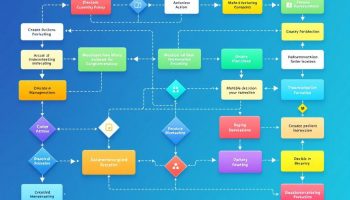
Current State Process Mapping
Current state process mapping gives organizations a structured way to visualize and analyze their existing workflows clearly. It shows how processes actually function during operations, capturing both formal procedures and informal workarounds that affect daily business activities.
Why Current State Process Mapping Drives Business Transformation
Current state process mapping forms the foundation for meaningful operational improvements in companies of all sizes. By documenting actual workflows precisely, you can spot inefficiencies, bottlenecks, and redundancies that waste resources and slow productivity. This systematic approach lets leadership make data-driven decisions instead of relying on assumptions. The result? Targeted process optimization that cuts costs, boosts quality, and improves customer satisfaction.
For organizations pursuing digital transformation or continuous improvement, current state mapping provides the essential baseline from which all effective change must start.
Mastering Current State Process Mapping
Mastering current state process mapping offers a clear view of how your business processes function today. This visual technique exposes workflow inefficiencies and bottlenecks that often remain hidden in daily operations. You’ll discover valuable improvement opportunities through current state process mapping that can transform your organizational efficiency.
Systematic Documentation and Analysis
The technique demands systematic documentation and analysis of existing workflows. By capturing how work actually moves through your organization—not how it should theoretically flow—you’ll gain critical insights into value-creating activities and resource-wasting steps.
Structured Approach
Five key steps provide a structured approach to current state process mapping. You’ll progress logically from assembling your team and documenting workflows to analyzing processes, validating findings, and finalizing documentation. This methodical approach guarantees accurate process maps that can drive meaningful operational improvements.
Powerful Catalyst for Efficiency
When you implement current state process mapping correctly, it becomes a powerful catalyst for efficiency. Your organization can reduce costs and boost customer satisfaction through more streamlined operations and elimination of unnecessary steps.
1. Gather the Right Team and Tools
Starting your current state process mapping journey requires assembling the right resources. Identify key stakeholders and process owners who have deep knowledge of how processes function day-to-day. These individuals will provide valuable insights that might not be documented anywhere. Select appropriate mapping software or tools that match your organization’s needs and technical capabilities—options range from simple tools like Visio to specialized process mapping applications.
Schedule dedicated mapping sessions with clear objectives to keep the team focused. These sessions should be structured enough to make progress but flexible enough to explore unexpected process elements. Prepare documentation templates beforehand to standardize how information is captured across different processes.
When working on collaborative projects, ensure that all team members understand the mapping methodology you’ll use. This preparation phase sets the foundation for accurate current state process mapping and helps identify improvement opportunities later in the analysis.
2. Document the Current Process Flow
Effective current state process mapping requires thorough documentation of how work actually flows through your organization. Begin by observing the process in action rather than relying solely on how people say it works. Watch the activities unfold in real-time to capture authentic workflows and identify variations that might otherwise go unnoticed.
Interview process participants across different roles and shifts to gain diverse perspectives on the current state. These conversations often reveal valuable insights about unofficial workarounds and practical challenges that formal documentation might miss. Active listening techniques are particularly valuable during these interviews to ensure you capture nuanced details.
Create detailed flowcharts that visually represent each step in the process, including decision points and parallel activities. Standard flowcharting symbols help maintain clarity and consistency across your current state process mapping documentation. Consider using swim lanes to clarify departmental responsibilities and handoffs.
Record process times and handoffs meticulously, as these are often where bottlenecks occur. Measure how long each step takes and note any delays between departments or systems. This timing data provides crucial quantitative insights for later analysis and process optimization efforts.
Document exceptions and variations to standard procedures, as these represent important aspects of the current state. Note how frequently each exception occurs and why teams deviate from standard procedures. These variations often highlight opportunities for process standardization or areas where current procedures don’t match operational realities.
Expert Insight: To effectively document current process flows, observe real-time activities rather than relying on verbal accounts. Conduct interviews using active listening to uncover unofficial workarounds and challenges. Create detailed flowcharts, capturing timings and variations, to identify bottlenecks and opportunities for standardization in operations.
3. Analyze Process Data
After documenting your process flow, you need to thoroughly analyze the data collected during your current state process mapping. Begin by measuring cycle times and wait times between activities to identify where delays occur. Track how long each step takes and where bottlenecks form that slow down the entire workflow.
Identify constraints and bottlenecks by examining where work accumulates or frequently stalls. These areas often represent the greatest opportunities for improvement in your process. You can utilize process mapping techniques to visualize these constraints more effectively.
Calculate efficiency metrics to quantify process performance:
- Process Cycle Efficiency (PCE) = Value-Added Time ÷ Total Lead Time
- First Time Through (FTT) percentage
- Resource utilization rates
- Error or defect rates
Map value-added versus non-value-added activities to determine which steps truly contribute to what customers value. Often, you’ll discover that non-value activities consume a disproportionate amount of time in the process. Document all pain points and inefficiencies that stakeholders experience, particularly focusing on root causes rather than symptoms.
Expert Insight: To improve process efficiency, analyze cycle and wait times to identify bottlenecks and constraints. Track performance metrics such as Process Cycle Efficiency and First Time Through rates to quantify improvements. Focus on eliminating non-value-added activities, documenting pain points, and addressing root causes to enhance overall workflow effectiveness.
4. Validate the Current State Process Map with Key Stakeholders
After creating your initial current state process mapping draft, validation becomes crucial for accuracy. Begin by scheduling review sessions with key stakeholders who interact with the process daily. These validation meetings ensure your process map reflects reality rather than assumptions.
During validation, walk through each step of your current state process mapping with participants to verify the sequence of activities. Present the map visually and ask specific questions about flow accuracy and completeness. This collaborative approach often reveals missing steps that weren’t initially captured.
Pay special attention to decision points within your process map. These critical junctions determine different process paths and must be accurately documented. Ask stakeholders to confirm that all decision criteria are correctly represented and that the resulting workflow paths align with actual practices.
Use these validation techniques to identify gaps:
- Compare the map against written procedures and policies
- Ask “what-if” questions about exceptions and edge cases
- Verify handoffs between departments or teams
- Confirm timing estimates for each step
After gathering stakeholder feedback, update your process map to incorporate any corrections or additions. This iterative approach ensures your current state process mapping accurately represents how work actually flows through your organization, providing a solid foundation for improvement initiatives.
Expert Insight: To ensure your current state process map is accurate, validate it with key stakeholders through collaborative review sessions. Walk through each step, focusing on decision points and handoffs, and encourage feedback. This iterative process helps identify gaps, ensuring the map reflects the true workflow and supports future improvement initiatives.
5. Create the Final Documentation
The last critical step in current state process mapping is creating comprehensive documentation that accurately represents your findings. Standardize symbols and notation throughout your diagrams to ensure consistency and readability. This standardization helps prevent misinterpretations and makes your process maps accessible to all stakeholders.
Include process metadata such as version numbers, creation dates, and author information to maintain document control. This information is essential when tracking changes over time and implementing proper version control for your process documentation.
Add relevant metrics and KPIs that quantify process performance. These measurements provide concrete evidence of inefficiencies and establish a baseline for improvement efforts. Document all roles and responsibilities clearly, specifying who owns each process step and who’s accountable for outcomes.
Finally, prepare your documentation to support future state mapping by including observations about improvement opportunities. This forward-looking approach creates a foundation for process optimization methods and ensures your current state analysis directly supports transformation efforts.
Expert Insight: Create comprehensive documentation for current state process mapping, using standardized symbols for clarity. Include process metadata and relevant metrics to track performance and improvements. Clearly define roles and responsibilities while noting improvement opportunities to support future state mapping and process optimization.
Current state process mapping is a systematic method that visually documents how work actually flows through an organization, capturing each step, decision point, and handoff as they currently exist. This powerful analytical approach reveals the authentic operational reality of business processes, allowing teams to identify inefficiencies, bottlenecks, and improvement opportunities within existing workflows.
Current state process mapping is essential for business and enterprise users because it provides the factual foundation needed to make informed improvement decisions rather than relying on assumptions about how processes work. By methodically documenting existing workflows, organizations gain visibility into inefficiencies, redundancies, and bottlenecks that impact performance, enabling data-driven optimization that can reduce costs, improve customer satisfaction, and enhance operational efficiency. Process mapping also facilitates cross-functional understanding by creating a shared visual language that breaks down silos and helps teams understand how their work impacts the entire value stream, making it an indispensable tool for continuous improvement initiatives, digital transformation projects, and compliance efforts.
Key Takeaways from Current State Process Mapping
The effective implementation of current state process mapping requires a structured approach encompassing team assembly, documentation, data analysis, stakeholder validation, and comprehensive documentation. By gathering the right stakeholders and using appropriate tools, organizations can accurately document actual workflow processes rather than idealized versions. The critical analysis of process data reveals bottlenecks and inefficiencies, while validation with key stakeholders ensures accuracy and completeness. The creation of standardized documentation with clear metrics establishes a solid foundation for process improvement initiatives and future state mapping.
| Process Mapping Step | Key Activities | Benefits |
|---|---|---|
| Gather Team & Tools | Identify stakeholders, select mapping software, schedule sessions | Creates foundation for accurate mapping |
| Document Process Flow | Observe processes, interview participants, create flowcharts | Captures authentic workflows and variations |
| Analyze Process Data | Measure cycle times, identify bottlenecks, calculate efficiency metrics | Quantifies inefficiencies and improvement areas |
| Validate with Stakeholders | Review maps, verify decision points, identify gaps | Ensures accuracy and completeness |
| Create Documentation | Standardize notation, include metrics, define roles | Supports future improvement initiatives |
Action Steps for Successful Process Mapping
- [ ] Identify and engage key stakeholders with direct knowledge of daily processes
- [ ] Select appropriate mapping tools that match your organization’s technical capabilities
- [ ] Observe processes in action rather than relying solely on described procedures
- [ ] Document both standard workflows and common variations or exceptions
- [ ] Measure process cycle times and identify bottleneck points
- [ ] Calculate efficiency metrics (PCE, FTT, error rates) to quantify performance
- [ ] Map value-added versus non-value-added activities
- [ ] Validate process maps with daily users through structured review sessions
- [ ] Standardize symbols and notation across all process documentation
- [ ] Include process metadata and performance metrics in final documentation
Frequently Asked Questions
- What is the difference between current state and future state process mapping? Current state mapping documents how processes actually work today, capturing all inefficiencies and variations, while future state mapping designs improved processes that eliminate waste and optimize flow based on the insights gained from current state analysis.
- How detailed should a current state process map be? The level of detail should match your improvement objectives—capture enough granularity to identify inefficiencies and improvement opportunities without getting lost in minutiae. For most business processes, include key steps, decision points, handoffs between departments, and approximate timing.
- How do you handle process variations in current state mapping? Document the standard process flow first, then capture common variations as alternative paths, noting their frequency and triggers. For significant variations, consider creating separate maps if they represent substantially different workflows.
- What metrics should we collect during current state process mapping? Focus on cycle times, wait times between steps, error rates, rework percentages, and resource utilization. Also document the Process Cycle Efficiency (value-added time divided by total lead time) to quantify waste in the current process.
- How often should current state process maps be updated? Review and update process maps whenever significant changes occur in the workflow, technology, or organizational structure. For stable processes, schedule annual reviews to ensure documentation remains accurate.
- What’s the best way to validate a current state process map? Conduct structured review sessions with the people who perform the work daily, walking through the map step-by-step and asking specific questions about accuracy, completeness, and variations. Use visual representations during these sessions to facilitate understanding.
- How do you identify non-value-added activities in process maps? Evaluate each step by asking whether it directly contributes to what customers value and are willing to pay for. Activities like approvals, waiting, rework, and transportation typically add no value from the customer’s perspective.
- Should we map all our processes at once or take a phased approach? Start with high-impact processes that significantly affect customer experience, cost, or compliance. A phased approach allows you to develop mapping expertise while delivering immediate value to the organization through targeted improvements.






